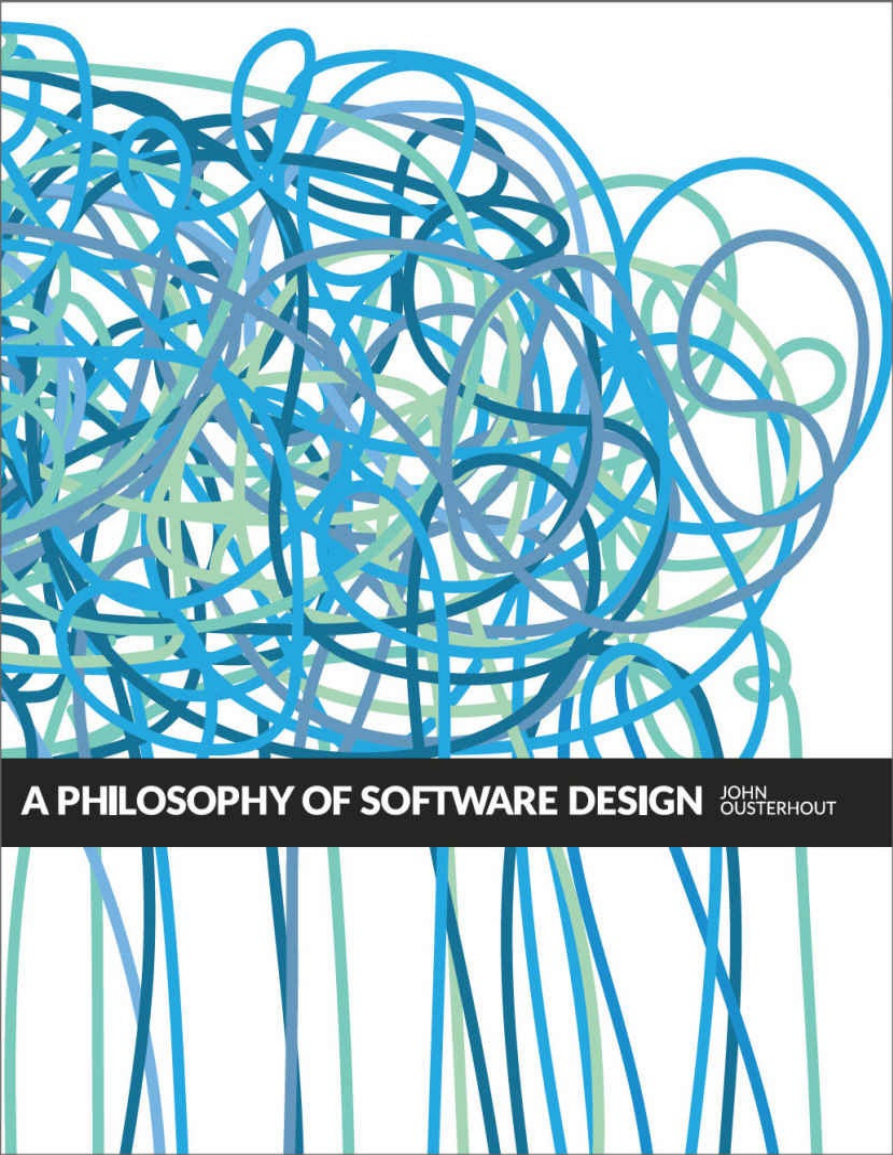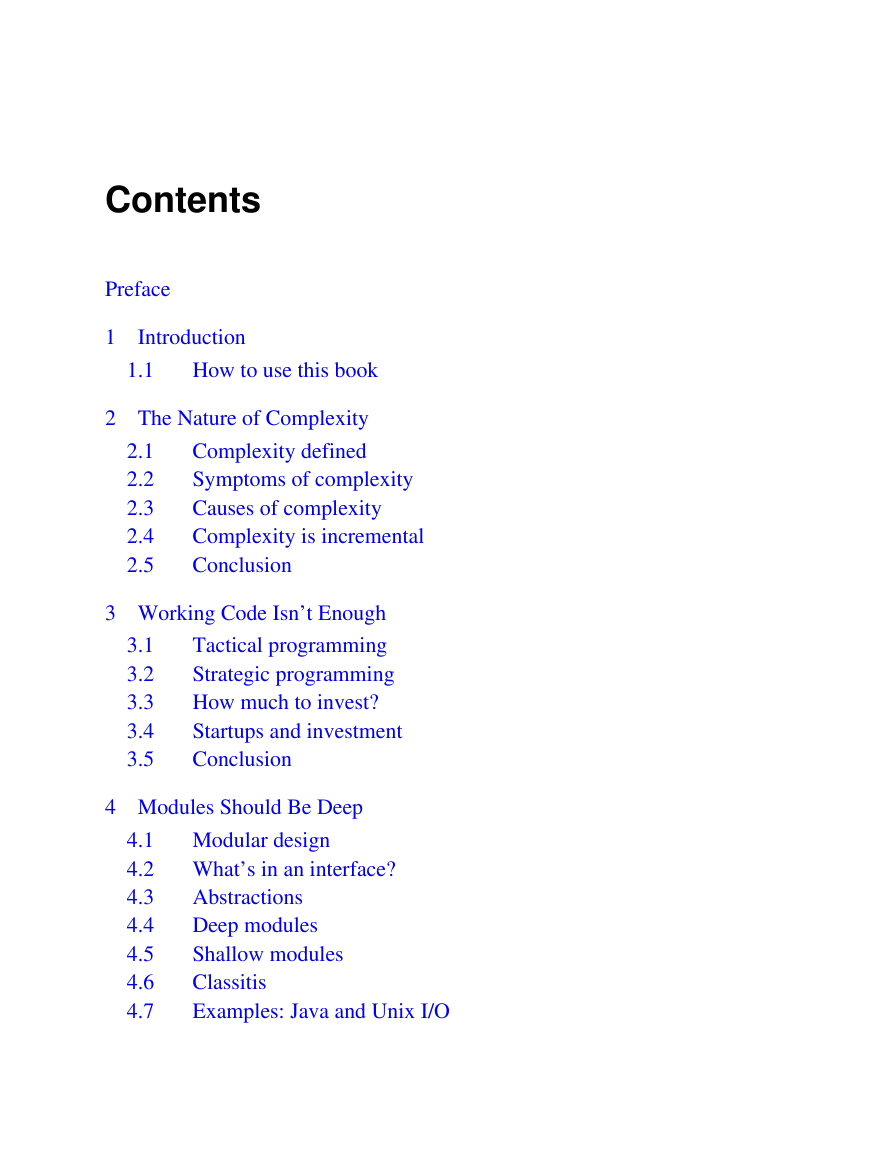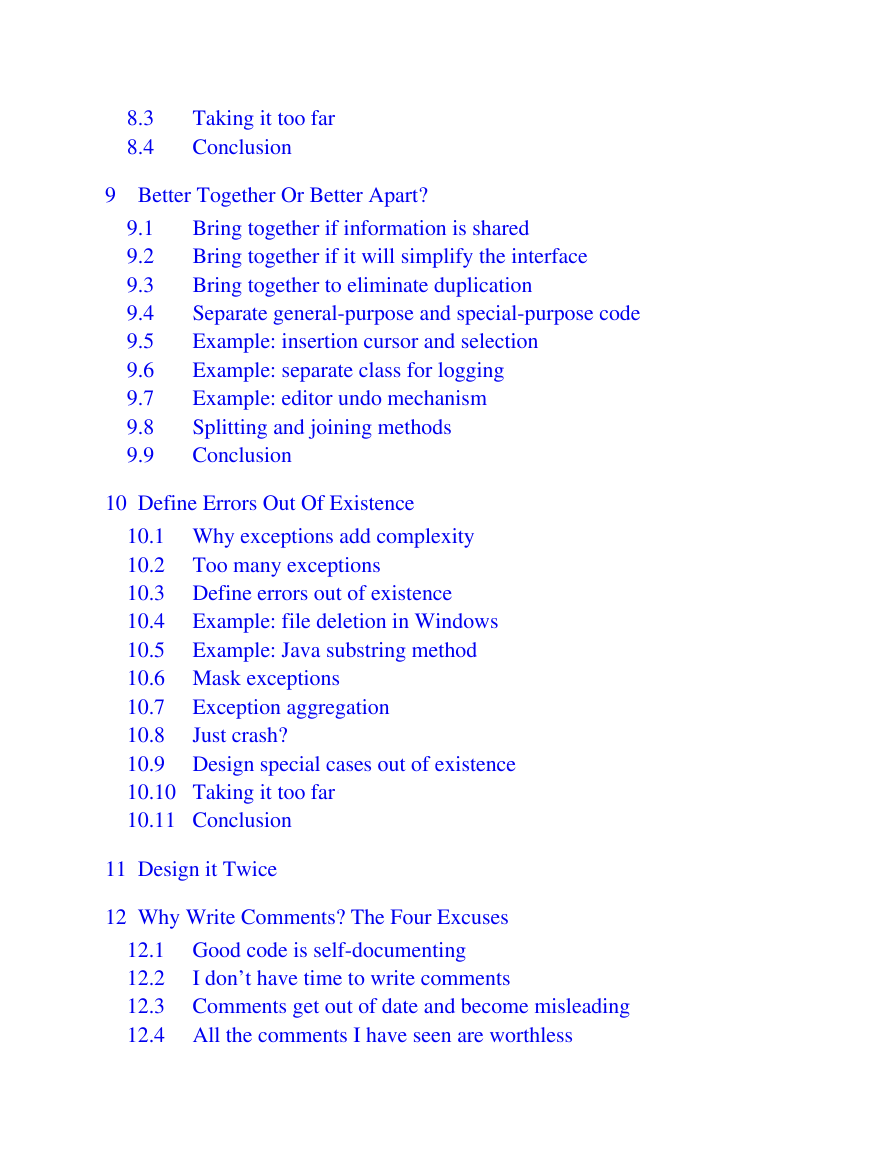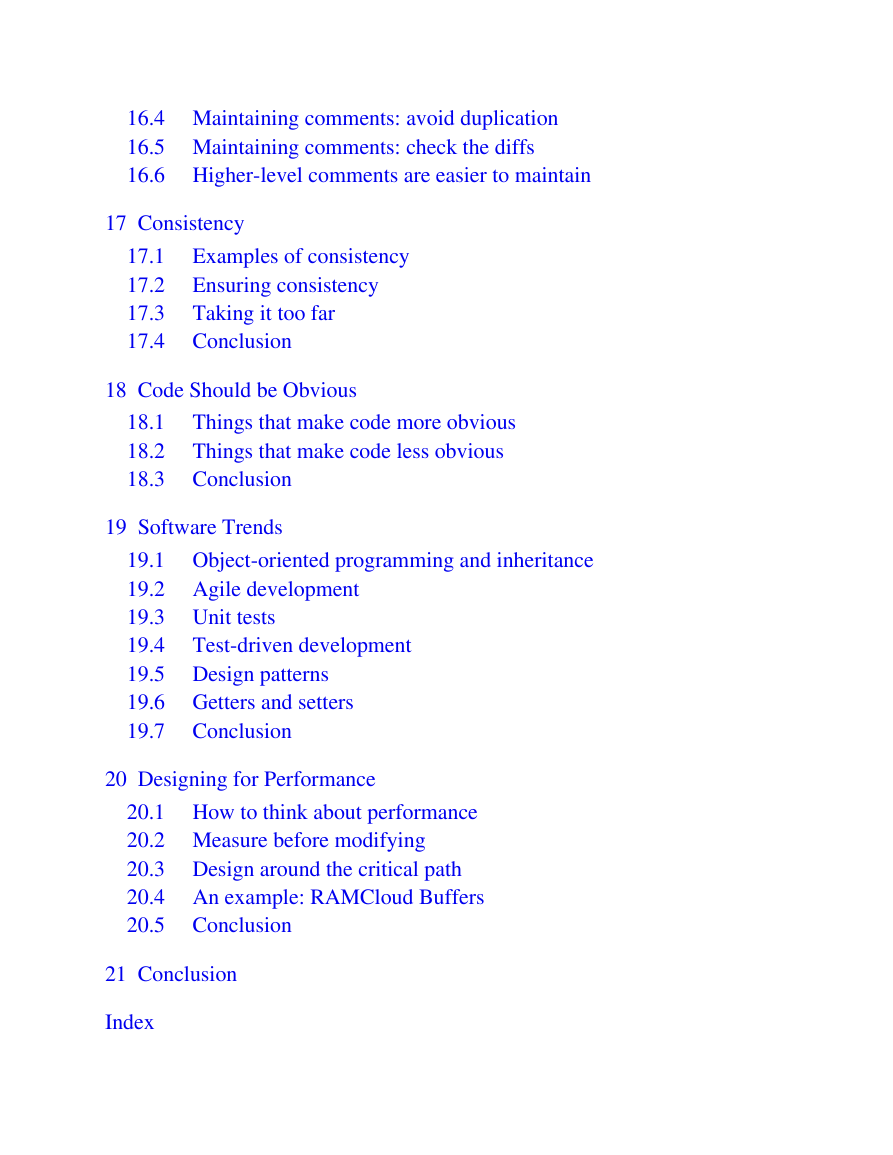Title Page
Copyright
Contents
Preface
1 Introduction
1.1 How to use this book
2 The Nature of Complexity
2.1 Complexity defined
2.2 Symptoms of complexity
2.3 Causes of complexity
2.4 Complexity is incremental
2.5 Conclusion
3 Working Code Isn’t Enough
3.1 Tactical programming
3.2 Strategic programming
3.3 How much to invest?
3.4 Startups and investment
3.5 Conclusion
4 Modules Should Be Deep
4.1 Modular design
4.2 What’s in an interface?
4.3 Abstractions
4.4 Deep modules
4.5 Shallow modules
4.6 Classitis
4.7 Examples: Java and Unix I/O
4.8 Conclusion
5 Information Hiding (and Leakage)
5.1 Information hiding
5.2 Information leakage
5.3 Temporal decomposition
5.4 Example: HTTP server
5.5 Example: too many classes
5.6 Example: HTTP parameter handling
5.7 Example: defaults in HTTP responses
5.8 Information hiding within a class
5.9 Taking it too far
5.10 Conclusion
6 General-Purpose Modules are Deeper
6.1 Make classes somewhat general-purpose
6.2 Example: storing text for an editor
6.3 A more general-purpose API
6.4 Generality leads to better information hiding
6.5 Questions to ask yourself
6.6 Conclusion
7 Different Layer, Different Abstraction
7.1 Pass-through methods
7.2 When is interface duplication OK?
7.3 Decorators
7.4 Interface versus implementation
7.5 Pass-through variables
7.6 Conclusion
8 Pull Complexity Downwards
8.1 Example: editor text class
8.2 Example: configuration parameters
8.3 Taking it too far
8.4 Conclusion
9 Better Together Or Better Apart?
9.1 Bring together if information is shared
9.2 Bring together if it will simplify the interface
9.3 Bring together to eliminate duplication
9.4 Separate general-purpose and special-purpose code
9.5 Example: insertion cursor and selection
9.6 Example: separate class for logging
9.7 Example: editor undo mechanism
9.8 Splitting and joining methods
9.9 Conclusion
10 Define Errors Out Of Existence
10.1 Why exceptions add complexity
10.2 Too many exceptions
10.3 Define errors out of existence
10.4 Example: file deletion in Windows
10.5 Example: Java substring method
10.6 Mask exceptions
10.7 Exception aggregation
10.8 Just crash?
10.9 Design special cases out of existence
10.10 Taking it too far
10.11 Conclusion
11 Design it Twice
12 Why Write Comments? The Four Excuses
12.1 Good code is self-documenting
12.2 I don’t have time to write comments
12.3 Comments get out of date and become misleading
12.4 All the comments I have seen are worthless
12.5 Benefits of well-written comments
13 Comments Should Describe Things that Aren’t Obvious from the Code
13.1 Pick conventions
13.2 Don’t repeat the code
13.3 Lower-level comments add precision
13.4 Higher-level comments enhance intuition
13.5 Interface documentation
13.6 Implementation comments: what and why, not how
13.7 Cross-module design decisions
13.8 Conclusion
13.9 Answers to questions on page 113
14 Choosing Names
14.1 Example: bad names cause bugs
14.2 Create an image
14.3 Names should be precise
14.4 Use names consistently
14.5 A different opinion: Go style guide
14.6 Conclusion
15 Write The Comments First
15.1 Delayed comments are bad comments
15.2 Write the comments first
15.3 Comments are a design tool
15.4 Early comments are fun comments
15.5 Are early comments expensive?
15.6 Conclusion
16 Modifying Existing Code
16.1 Stay strategic
16.2 Maintaining comments: keep the comments near the code
16.3 Comments belong in the code, not the commit log
16.4 Maintaining comments: avoid duplication
16.5 Maintaining comments: check the diffs
16.6 Higher-level comments are easier to maintain
17 Consistency
17.1 Examples of consistency
17.2 Ensuring consistency
17.3 Taking it too far
17.4 Conclusion
18 Code Should be Obvious
18.1 Things that make code more obvious
18.2 Things that make code less obvious
18.3 Conclusion
19 Software Trends
19.1 Object-oriented programming and inheritance
19.2 Agile development
19.3 Unit tests
19.4 Test-driven development
19.5 Design patterns
19.6 Getters and setters
19.7 Conclusion
20 Designing for Performance
20.1 How to think about performance
20.2 Measure before modifying
20.3 Design around the critical path
20.4 An example: RAMCloud Buffers
20.5 Conclusion
21 Conclusion
Index
Summary of Design Principles
Summary of Red Flags
About the Author
















 2023年江西萍乡中考道德与法治真题及答案.doc
2023年江西萍乡中考道德与法治真题及答案.doc 2012年重庆南川中考生物真题及答案.doc
2012年重庆南川中考生物真题及答案.doc 2013年江西师范大学地理学综合及文艺理论基础考研真题.doc
2013年江西师范大学地理学综合及文艺理论基础考研真题.doc 2020年四川甘孜小升初语文真题及答案I卷.doc
2020年四川甘孜小升初语文真题及答案I卷.doc 2020年注册岩土工程师专业基础考试真题及答案.doc
2020年注册岩土工程师专业基础考试真题及答案.doc 2023-2024学年福建省厦门市九年级上学期数学月考试题及答案.doc
2023-2024学年福建省厦门市九年级上学期数学月考试题及答案.doc 2021-2022学年辽宁省沈阳市大东区九年级上学期语文期末试题及答案.doc
2021-2022学年辽宁省沈阳市大东区九年级上学期语文期末试题及答案.doc 2022-2023学年北京东城区初三第一学期物理期末试卷及答案.doc
2022-2023学年北京东城区初三第一学期物理期末试卷及答案.doc 2018上半年江西教师资格初中地理学科知识与教学能力真题及答案.doc
2018上半年江西教师资格初中地理学科知识与教学能力真题及答案.doc 2012年河北国家公务员申论考试真题及答案-省级.doc
2012年河北国家公务员申论考试真题及答案-省级.doc 2020-2021学年江苏省扬州市江都区邵樊片九年级上学期数学第一次质量检测试题及答案.doc
2020-2021学年江苏省扬州市江都区邵樊片九年级上学期数学第一次质量检测试题及答案.doc 2022下半年黑龙江教师资格证中学综合素质真题及答案.doc
2022下半年黑龙江教师资格证中学综合素质真题及答案.doc